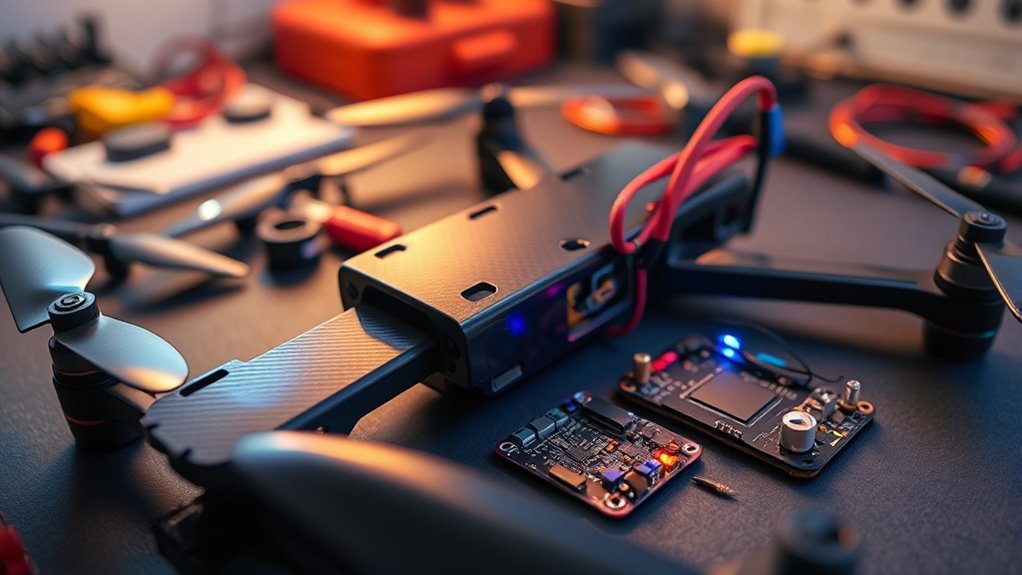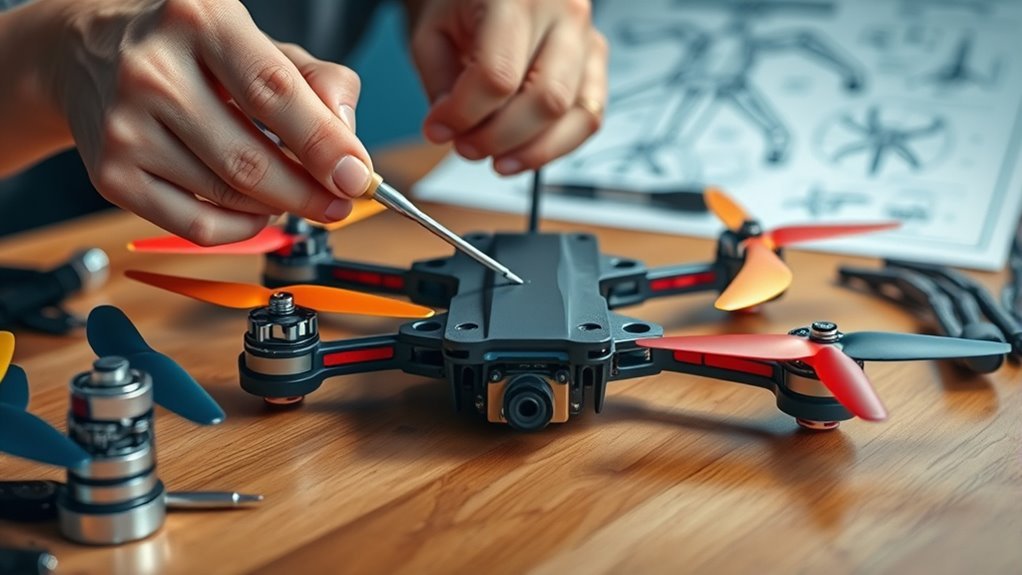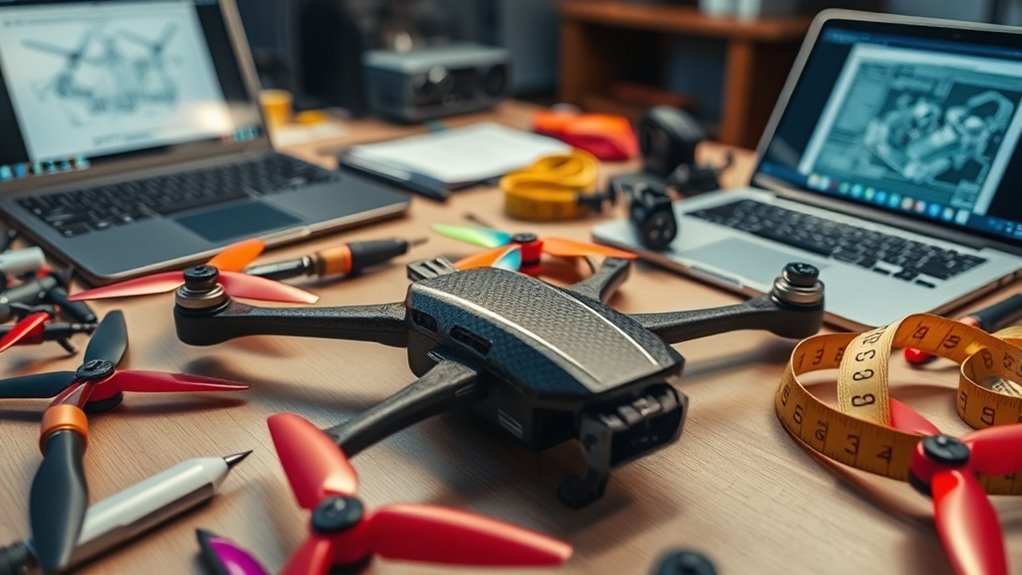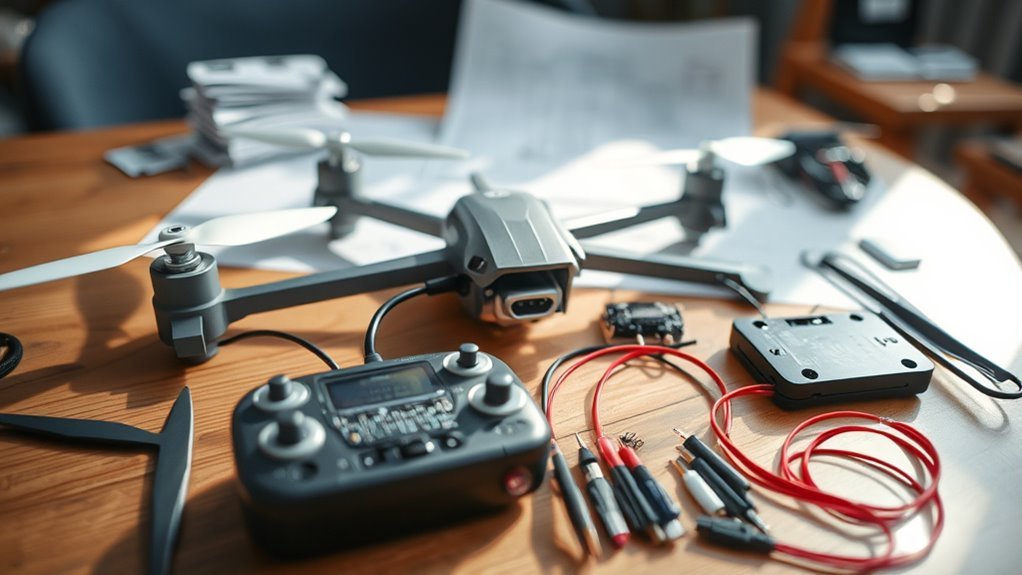To build a drone, start by understanding basic components like motors, frames, and flight controllers. Gather necessary materials and choose quality parts that are compatible. Assemble your drone carefully, ensuring all connections are secure. After assembly, program and calibrate your drone for peak performance. Always prioritize safety and conduct thorough pre-flight checks. With these steps, you’ll be well on your way to flying your drone, and there’s much more to explore in this exciting hobby.
Understanding Drone Basics

Drones, often referred to as unmanned aerial vehicles (UAVs), have revolutionized various industries by providing versatile aerial capabilities. Understanding the different drone types is essential for effectively leveraging drone technology. You’ll encounter multi-rotor drones, which offer stability and ease of use, making them ideal for beginners. Fixed-wing drones are better suited for long-distance flights due to their aerodynamic design. Additionally, hybrid drones combine elements of both, maximizing efficiency. Each type serves distinct purposes, from aerial photography to agricultural monitoring. Familiarizing yourself with these classifications allows you to select the right drone for your objectives, whether for recreational use or professional applications. Ultimately, grasping these fundamentals empowers you to navigate the expansive world of drone technology with confidence. Moreover, understanding signal attenuation is crucial for optimizing drone performance in various environments. Drones equipped with advanced camera capabilities can significantly enhance the quality of the visuals captured during flights.
Gathering the Necessary Materials

Before you can start building your drone, it’s vital to gather all the necessary materials. Begin with material sourcing; identify where you’ll obtain components like motors, propellers, and frames. Consider reputable suppliers, both online and local, to guarantee quality and availability.
Next, focus on budget planning. Outline your financial limits and prioritize important parts over optional upgrades. This approach helps you avoid overspending while still achieving your drone objectives.
Don’t forget tools like soldering kits, screwdrivers, and safety equipment, which are essential for assembly. Additionally, understanding the typical lifespan of drones will help you make informed choices about the components you select. By effectively sourcing materials and planning your budget, you’ll set a solid foundation for your drone-building project, empowering you to create a machine that aligns with your vision of freedom in the skies.
Choosing the Right Components

When choosing the right components for your drone, it’s vital to identify the essential parts, including motors, flight controllers, and batteries. You’ll also need to take into account compatibility between these components to guarantee peak performance. A well-matched assembly can greatly enhance your drone’s efficiency and functionality. Additionally, considering motor power is crucial, as it determines thrust and acceleration, impacting overall speed and performance.
Essential Drone Parts
Building a drone requires a careful selection of essential components that directly impact its performance and capabilities. To start, you’ll need drone motors, which determine thrust and maneuverability; selecting the right size and power rating is critical. Next, focus on the flight controller, the brain of your drone, responsible for stability and navigation. It interfaces with various sensors and communicates with the motors, enabling precise control. Confirm your flight controller supports the features you want, like GPS or autonomous flight. Additionally, consider other components like ESCs (Electronic Speed Controllers), batteries, and frames, each playing an essential role in overall performance. Choosing these parts wisely will empower you to create a drone tailored to your specific needs and flying style.
Compatibility Considerations
Selecting compatible components is essential for guaranteeing your drone operates effectively and efficiently. To achieve peak performance, focus on part compatibility and component matching across the following areas:
- Flight Controller: Verify it’s compatible with your chosen motors and ESCs, as different controllers support varying protocols.
- Motors: Match motor specifications, like KV rating, with your propeller size and battery voltage to prevent underperformance.
- Battery: Choose a battery that matches the voltage and capacity requirements of your flight controller and motors for balanced power delivery.
Assembling Your Drone
Although assembling your drone may seem challenging at first, it becomes manageable when you follow a systematic approach. Begin by laying out all components, guaranteeing compatibility. Use drone assembly techniques like connecting the flight controller to the motors and ESCs, and securely mounting the frame. As you proceed, double-check each connection to minimize errors. If you encounter issues, troubleshooting common problems such as loose wires or incorrect soldering can save you time. Ascertain the battery is properly connected and that the propellers are installed in the correct orientation. By adhering to these methods, you’ll streamline the assembly process and enhance your drone’s performance, ultimately enjoying the freedom that comes with flying your custom-built drone.
Programming and Calibrating Your Drone
Once your drone is assembled, the next step is programming and calibrating it to guarantee peak performance. You’ll want to choose the right programming languages to customize your flight experience. Follow these calibration techniques for ideal results:
- Gyroscope Calibration: Verify your drone’s gyroscope is set correctly to maintain stability during flight.
- Accelerometer Calibration: Adjust the accelerometer to reflect the drone’s positional data accurately, enhancing responsiveness.
- ESC Calibration: Calibrate the Electronic Speed Controllers to confirm balanced motor speeds, vital for smooth maneuvering.
Safety Tips for Flying Your Drone
Before you take to the skies, you need to perform a thorough pre-flight checklist to guarantee your drone is ready for operation. Understanding no-fly zones is essential to avoid legal issues and guarantee safety. Additionally, familiarize yourself with emergency landing procedures to handle unexpected situations effectively. Always ensure compliance with federal aviation regulations to operate your drone legally and safely. Furthermore, being aware of local drone regulations can help you navigate legal complexities and enhance your flying experience.
Pre-Flight Checklist Essentials
A thorough pre-flight checklist is essential for guaranteeing the safety and functionality of your drone. Before you take to the skies, follow these critical steps:
- Battery Check: Confirm your battery is fully charged and securely connected. Inspect for any signs of damage or swelling, as this can affect performance.
- Propeller Inspection: Examine each propeller for any cracks, bends, or debris. Properly aligned and undamaged propellers are essential for stable flight.
- Control System Test: Verify that your remote control and drone are communicating effectively. Check all controls for responsiveness to guarantee seamless operation.
No-Fly Zones Awareness
Understanding your pre-flight checklist is only part of guaranteeing safe operations; being aware of no-fly zones is equally important. These zones, often established due to safety concerns, can include areas around airports, government buildings, and populated regions. Ignoring these legal regulations can result in severe penalties, including fines or drone confiscation. To navigate this landscape effectively, always check local laws and use apps that provide real-time data on no-fly zones. Before each flight, verify your drone’s GPS is updated to avoid unintentional incursions into restricted areas. Being proactive not only safeguards your freedom to fly but also protects the safety of others. Prioritize compliance to enjoy your drone experience without legal repercussions.
Emergency Landing Procedures
While flying your drone can be an exhilarating experience, knowing how to execute emergency landing procedures is essential for ensuring safety. In unexpected situations, following established emergency protocols can minimize risks. Here are three crucial landing techniques to master:
- Controlled Descent: Gradually reduce altitude while maintaining control. This helps avoid sudden drops and potential damage.
- Return-to-Home Function: Utilize this feature if your drone loses connection. It automatically directs your drone back to the launch point.
- Safe Landing Zone Selection: Always identify a clear, open area for landing. Avoid crowds, obstacles, and power lines to reduce hazards.
Practicing these techniques prepares you for emergencies, ensuring your freedom to fly remains intact while prioritizing safety.
Frequently Asked Questions
What Is the Best Drone for Beginners?
For beginners, the best beginner drones combine user-friendly controls, stable flight features, and decent battery life. Look for models with integrated cameras and GPS, ensuring you have an enjoyable, hassle-free flying experience right from the start.
How Long Does It Take to Build a Drone?
When it comes to drone assembly time, it’s a mixed bag. With beginner drone kits, you can expect anywhere from a couple of hours to a few days, depending on complexity and your experience level.
Can I Use Old Electronics for My Drone?
Yes, you can use old electronics for your drone. Recycling electronics can provide valuable drone components, but make certain they’re compatible and functional. Testing their performance is essential to maintain safety and reliability during operation.
What Are Common Mistakes to Avoid When Building a Drone?
When building a drone, avoid common mistakes like improper battery selection, which can affect flight times, and using unsuitable frame material, leading to instability. Prioritize quality components to guarantee peak performance and reliability in the air.
How Much Does It Typically Cost to Build a Drone?
Ever wondered how much freedom you can achieve with a drone? Typically, building one costs between $200 to $1,500, depending on drone components and budget considerations. Choose wisely to maximize both performance and your investment.

